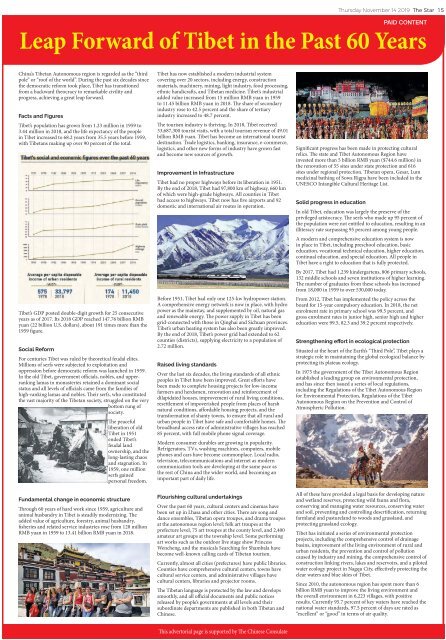The Star: November 14, 2019
You also want an ePaper? Increase the reach of your titles
YUMPU automatically turns print PDFs into web optimized ePapers that Google loves.
Thursday <strong>November</strong> <strong>14</strong> <strong>2019</strong> <strong>The</strong> <strong>Star</strong> 15<br />
PAID CONTENT<br />
Leap Forward of Tibet in the Past 60 Years<br />
China’s Tibetan Autonomous region is regarded as the “third<br />
pole” or “roof of the world”. During the past six decades since<br />
the democratic reform took place, Tibet has transitioned<br />
from a backward theocracy to remarkable civility and<br />
progress, achieving a great leap forward.<br />
Facts and Figures<br />
Tibet’s population has grown from 1.23 million in 1959 to<br />
3.44 million in 2018, and the life expectancy of the people<br />
in Tibet increased to 68.2 years from 35.5 years before 1959,<br />
with Tibetans making up over 90 percent of the total.<br />
Tibet’s GDP posted double-digit growth for 25 consecutive<br />
years as of 2017. Its 2018 GDP reached <strong>14</strong>7.76 billion RMB<br />
yuan (22 billion U.S. dollars), about 191 times more than the<br />
1959 figure.<br />
Social Reform<br />
For centuries Tibet was ruled by theoretical feudal elites.<br />
Millions of serfs were subjected to exploitation and<br />
oppression before democratic reform was launched in 1959.<br />
In the old Tibet, government officials, nobles, and upperranking<br />
lamas in monasteries retained a dominant social<br />
status and all levels of officials came from the families of<br />
high-ranking lamas and nobles. <strong>The</strong>ir serfs, who constituted<br />
the vast majority of the Tibetan society, struggled on the very<br />
bottom rung of<br />
society.<br />
<strong>The</strong> peaceful<br />
liberation of old<br />
Tibet in 1951<br />
ended Tibet’s<br />
feudal land<br />
ownership, and the<br />
long-lasting chaos<br />
and stagnation. In<br />
1959, one million<br />
serfs gained<br />
personal freedom.<br />
Tibet has now established a modern industrial system<br />
covering over 20 sectors, including energy, construction<br />
materials, machinery, mining, light industry, food processing,<br />
ethnic handicrafts, and Tibetan medicine. Tibet’s industrial<br />
added value increased from 15 million RMB yuan in 1959<br />
to 11.45 billion RMB yuan in 2018. <strong>The</strong> share of secondary<br />
industry rose to 42.5 percent and the share of tertiary<br />
industry increased to 48.7 percent.<br />
<strong>The</strong> tourism industry is thriving. In 2018, Tibet received<br />
33,687,300 tourist visits, with a total tourism revenue of 49.01<br />
billion RMB yuan. Tibet has become an international tourist<br />
destination. Trade logistics, banking, insurance, e-commerce,<br />
logistics, and other new forms of industry have grown fast<br />
and become new sources of growth.<br />
Improvement in Infrastructure<br />
Tibet had no proper highways before its liberation in 1951.<br />
By the end of 2018, Tibet had 97,800 km of highway, 660 km<br />
of which were high-grade highways. All counties in Tibet<br />
had access to highways. Tibet now has five airports and 92<br />
domestic and international air routes in operation.<br />
Before 1951, Tibet had only one 125-kw hydropower station.<br />
A comprehensive energy network is now in place, with hydro<br />
power as the mainstay, and supplemented by oil, natural gas<br />
and renewable energy. <strong>The</strong> power supply in Tibet has been<br />
grid-connected with those in Qinghai and Sichuan provinces.<br />
Tibet’s urban heating system has also been greatly improved.<br />
By the end of 2018, Tibet’s power grid had extended to 62<br />
counties (districts), supplying electricity to a population of<br />
2.72 million.<br />
Raised living standards<br />
Over the last six decades, the living standards of all ethnic<br />
peoples in Tibet have been improved. Great efforts have<br />
been made to complete housing projects for low-income<br />
farmers and herdsmen, renovation and reinforcement of<br />
dilapidated houses, improvement of rural living conditions,<br />
resettlement of impoverished people from places of harsh<br />
natural conditions, affordable housing projects, and the<br />
transformation of shanty towns, to ensure that all rural and<br />
urban people in Tibet have safe and comfortable homes. <strong>The</strong><br />
broadband access rate of administrative villages has reached<br />
85 percent, with full mobile phone signal coverage.<br />
Modern consumer durables are growing in popularity.<br />
Refrigerators, TVs, washing machines, computers, mobile<br />
phones and cars have become commonplace. Local radio,<br />
television, telecommunications and internet as modern<br />
communication tools are developing at the same pace as<br />
the rest of China and the wider world, and becoming an<br />
important part of daily life.<br />
Significant progress has been made in protecting cultural<br />
relics. <strong>The</strong> state and Tibet Autonomous Region have<br />
invested more than 5 billion RMB yuan ($744.6 million) in<br />
the renovation of 55 sites under state protection and 616<br />
sites under regional protection. Tibetan opera, Gesar, Lum<br />
medicinal bathing of Sowa Rigpa have been included in the<br />
UNESCO Intangible Cultural Heritage List.<br />
Solid progress in education<br />
In old Tibet, education was largely the preserve of the<br />
privileged aristocracy. <strong>The</strong> serfs who made up 95 percent of<br />
the population were not entitled to education, resulting in an<br />
illiteracy rate surpassing 95 percent among young people.<br />
A modern and comprehensive education system is now<br />
in place in Tibet, including preschool education, basic<br />
education, vocational technical education, higher education,<br />
continual education, and special education. All people in<br />
Tibet have a right to education that is fully protected.<br />
By 2017, Tibet had 1,239 kindergartens, 806 primary schools,<br />
132 middle schools and seven institutions of higher learning.<br />
<strong>The</strong> number of graduates from these schools has increased<br />
from 18,000 in 1959 to over 530,000 today.<br />
From 2012, Tibet has implemented the policy across the<br />
board for 15-year compulsory education. In 2018, the net<br />
enrolment rate in primary school was 99.5 percent, and<br />
gross enrolment rates in junior high, senior high and higher<br />
education were 99.5, 82.3 and 39.2 percent respectively.<br />
Strengthening effort in ecological protection<br />
Situated at the heart of the Earth’s “Third Pole”, Tibet plays a<br />
strategic role in maintaining the global ecological balance by<br />
protecting its plateau ecology.<br />
In 1975 the government of the Tibet Autonomous Region<br />
established a leading group on environmental protection,<br />
and has since then issued a series of local regulations,<br />
including the Regulations of the Tibet Autonomous Region<br />
for Environmental Protection, Regulations of the Tibet<br />
Autonomous Region on the Prevention and Control of<br />
Atmospheric Pollution.<br />
Fundamental change in economic structure<br />
Through 60 years of hard work since 1959, agriculture and<br />
animal husbandry in Tibet is steadily modernizing. <strong>The</strong><br />
added value of agriculture, forestry, animal husbandry,<br />
fisheries and related service industries rose from 128 million<br />
RMB yuan in 1959 to 13.41 billion RMB yuan in 2018.<br />
Flourishing cultural undertakings<br />
Over the past 60 years, cultural centers and cinemas have<br />
been set up in Lhasa and other cities. <strong>The</strong>re are song and<br />
dance ensembles, Tibetan opera troupes, and drama troupes<br />
at the autonomous region level; folk art troupes at the<br />
prefecture level, 75 art troupes at the county level, and 2,400<br />
amateur art groups at the township level. Some performing<br />
art works such as the outdoor live stage show Princess<br />
Wencheng, and the musicals Searching for Shambala have<br />
become well-known calling cards of Tibetan tourism.<br />
Currently, almost all cities (prefectures) have public libraries.<br />
Counties have comprehensive cultural centers, towns have<br />
cultural service centers, and administrative villages have<br />
cultural centers, libraries and projector rooms.<br />
<strong>The</strong> Tibetan language is protected by the law and develops<br />
smoothly, and all official documents and public notices<br />
released by people’s governments at all levels and their<br />
subordinate departments are published in both Tibetan and<br />
Chinese.<br />
This advertorial is paid for by the Chinese Consulate<br />
This advertorial page is supported by <strong>The</strong> Chinese Consulate<br />
All of these have provided a legal basis for developing nature<br />
and wetland reserves, protecting wild fauna and flora,<br />
conserving and managing water resources, conserving water<br />
and soil, preventing and controlling desertification, returning<br />
farmland and pastureland to woods and grassland, and<br />
protecting grassland ecology.<br />
Tibet has initiated a series of environmental protection<br />
projects, including the comprehensive control of drainage<br />
basins, improvement of the living environment of rural and<br />
urban residents, the prevention and control of pollution<br />
caused by industry and mining, the comprehensive control of<br />
construction linking rivers, lakes and reservoirs, and a piloted<br />
water ecology project in Nagqu City, effectively protecting the<br />
clear waters and blue skies of Tibet.<br />
Since 2010, the autonomous region has spent more than 6<br />
billion RMB yuan to improve the living environment and<br />
the overall environment in 6,223 villages, with positive<br />
results. Currently 95.7 percent of key waters have reached the<br />
national water standards, 97.5 percent of days are rated as<br />
“excellent” or “good” in terms of air quality.


















